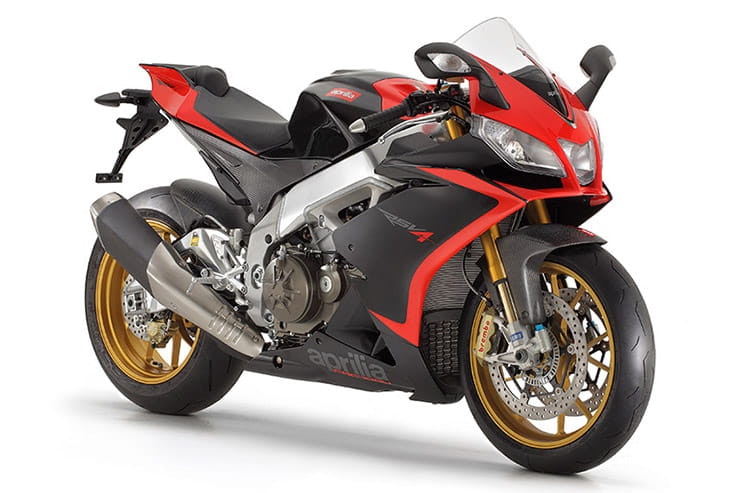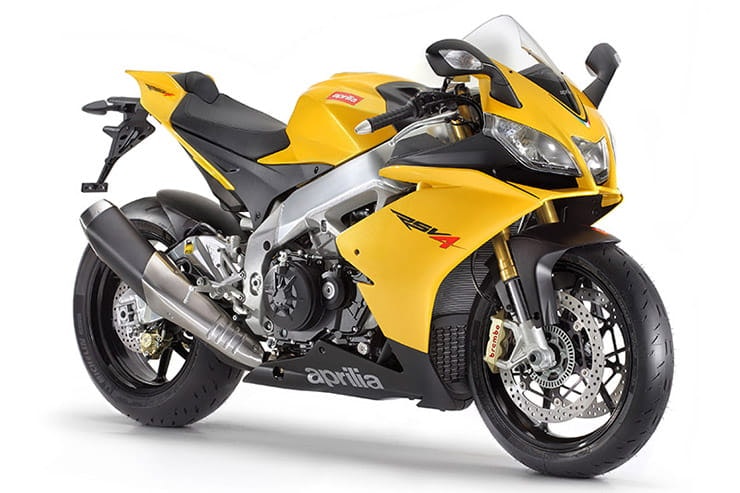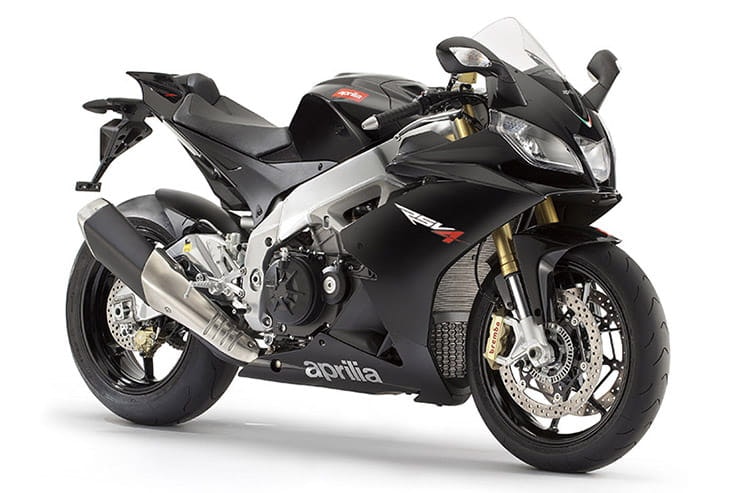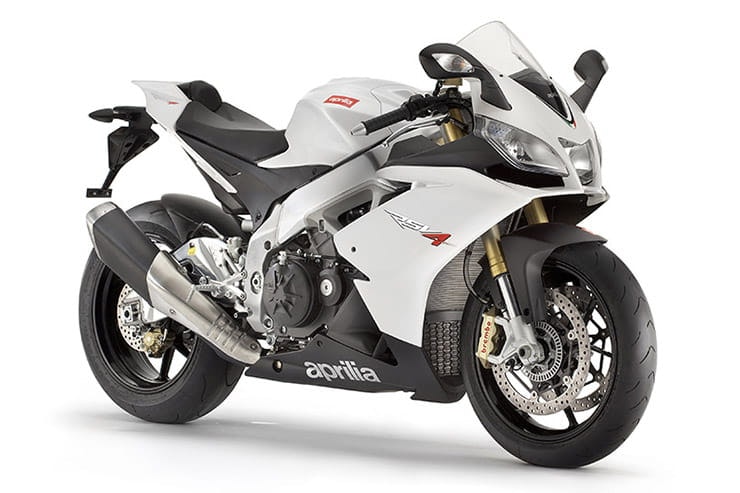Aprilia RSV4 R and Factory APRC (2012) - Review & Buying Guide
By Jon Urry
Massively experienced road tester
15.05.2023
Price: £6000-£8000 | Power: 180bhp | Weight: 179kg | Overall BikeSocial Rating: 4/5
The history of Aprilia’s mind-blowing V4 superbike is a touch complicated as in its early years the firm tended to update it fairly regularly as well as dropping a few ‘limited edition’ models into the equation. Which is exactly what happened in 2012. After launching the top-spec RSV4 Factory in 2009 alongside (a little while later, for reasons we will discuss later...) the base RSV4 R model, in 2011 Aprilia release the RSV4 Factory SE APRC model, which gained a more advanced APRC electronics package. Standing for Aprilia Performance Ride Control, APRC added traction control, wheelie control, launch control and a quickshifter to the party – all controlled by angle-responsive gyros and accelerometers. A year later the firm then rolled out this electronics package to both the base RSV4 R and also the RSV4 Factory, creating the RSV4 R APRC and the RSV4 Factory APRC models. Only lasting for a year before they were updated in 2013 when the bikes gained a bigger tank, ABS and slight engine upgrades, the 2012 APRC bikes are something of stop-gap models but if you aren’t fussed about ABS or a marginally bigger fuel range, they are well worth considering. Naturally you have to remember that they are early RSV4 models and so you need to be a touch careful when buying but if you are talking value for money, the RSV4 and especially the RSV4 Factory don’t half give you a stack of V4 bang for your buck.
Aprilia RSV4 R and RSV4 Factory APRC (2012) Price
Brand new the base model RSV4 R cost £14,000 where the top-spec Factory version was £17,000, which was good value when you consider the Ducati 1199 Panigale was £15,000 and the S model was £20,000 – and it never won a WSB title! But there was a catch and Aprilia models never sell that well in the UK and after a few teething issues with the RSV4 R, buyers were a bit wary of them, resulting in prices dropping. Nowadays Aprilia still remain generally undervalued in the used market and you can pick up a base model 2012 RSV4 R for as little as £6000 with the Factory upping this by about £1000. A really good example of the Factory will cost you £8000 where a mint R is generally about £750-£1000 less.
High spec list with a low price tag
Staggering performance, amazing electronics
A proven WSB winner
Reliability is always a worry
It’s very small and compact
Quite an argumentative engine when you aren’t in the mood!
Engine and Performance
Aprilia’s V4 engine is a remarkable motor and absolutely ballistic in its performance. Identical in both models (both the R and Factory APRC models feature variable length intake ducts in their airboxes, unlike the first generation where only the Factory got them), it remains incredibly impressive to this day in both the ferocity of its acceleration and its amazing exhaust note. Although the early one ‘only’ makes a claimed 180bhp with 115Nm of torque, that is still more than enough for road riding and you really don’t miss the latest bigger-capacity model’s extra 20bhp when you are anywhere aside from a race track. But, and this is a bit of a big BUT (as Sir Mixalot likes..), the early engine does have its issues...
Ignore anyone who mentions snapping conrods, that was a quirk of very early RSV4 R models and only affected a very few bikes. What you need to be more worried about is the cam chain tensioner... Aprilia never really got to grips with the cam chain tensioner on the early RSV4 motor and it has been updated a few times. You can put a newer one on an older V4 engine for better reliability but you need to know your stuff so always take it to an expert to ensure you get the right one. When starting the bike from cold, listen for a tell-tale rattle from the engine (generally front cylinders) and if it rattles a lot even once warm, assume the tensioner is on its way out and factor in a bill of about £300-£400 to swap them both. The 2012 bike was subject to one recall which was related to a ‘sudden loss of power due to valves dropping due to premature wear of the valve cap’ – but only three bikes in the UK were actually affected so you should be safe! That said, just check its VIN with Aprilia...
On to the gearbox and this is a biggy. The quickshifter causes premature wear of the gearbox, almost to the point it is considered a consumable part. Always take the bike out for a test ride and check it holds gear under hard acceleration and the action is nice and slick. The good news (if that is the right term...) is that should it go the gearbox is a cassette design, making it easier to swap, but even so you are looking at a hefty bill to sort out should the gearbox fail. Track bikes and road bikes are both affected (more so track ones) and so you need to be wary.
When it comes to servicing, the RSV4’s compact nature makes it a total nightmare to work on and while the minor service is ok, the major is a massive pain as checking the valve clearances is a real fight. The clearances need to be checked every 12,000 miles, which will set you back over £600 and is often skipped by owners.
Finally, always check for any warning lights on the dash as they can spell disaster. Generally it will be down to the exhaust valve sticking (or an aftermarket can junking the valve and the fault code not cleared) but if it isn’t the valve you are opening a can of electrical worms...
Aprilia RSV4 R and RSV4 Factory APRC (2012) Handling & Suspension
If you are on a smooth and twisty road, the RSV4 is absolutely staggering. And if you are on track it is even better. A proper track bike with lights, the Aprilia feels like a supersport 600 to ride and is unbelievably agile and fast-turning – which is great on the right roads but a bit tricky when not...
Due to its brutal power delivery and sharp-turning chassis, the RSV4 can be a touch lively when you are on a bumpy road and that can be a bit intimidating. The suspension, as you would expect, is set quite firmly and this, combined with the aggressive riding position, can take its toll, making the RSV4 is far from a relaxing bike to ride. If you like a challenge it is probably one of the best-handling bikes out there but it will give you a serious workout and for this reason, a lot find their way on track.
When buying used always be wary of ex-track bikes or those that are taken on track regularly. As well as the obvious potential crash damage, track use will wear out components such as brake discs and the gearbox faster so ideally are best avoided.
When it comes to suspension, the Factory’s Öhlins units are fully-rebuildable where the R’s Sachs shock isn’t, which is worth considering, and with the Factory you get lightweight wheels as standard, which make a noticeable difference to the bike’s agility. It’s a double edged sword as the R’s heavier wheels make it a bit more stable on the UK’s bumpy roads and are also less prone to dings but the Factory’s lightweight ones not only look better but also make the bike faster-turning. If you are buying a Factory, always inspect the wheel rims well for any dents and also check the Öhlins fork’s seals as they can start to weep if the bike is left standing for a long period of time. On both models inspect the fairing for cracks as it is quite brittle and heavy-handed DIY can see it crack. And no, there is no need to either alter the Factory’s geometry or its engine’s position in the frame – just because you can doesn’t mean you need to!!!
Comfort & Economy
Oh good grief no, the RSV4 scores very low on both of these counts. In terms of comfort the RSV4 is extremely compact, very aggressive in its riding stance and the seat has virtually no padding. Long distance is a right old pain – quite literally. Smaller riders may get on ok with it but taller riders will struggle and as for pillions – well, just look at that rear end! And the V4 does have a habit of cooking your inner thigh on a warm day as it runs very hot...
If you are talking economy, again, don’t expect much. If you get over 40mpg you are doing well and generally you are talking 120 miles until the fuel warning illuminates and maybe 20-30 miles left until you run dry. Stories of sub-100 miles until reserve aren’t uncommon... The updated 2013 model has a larger 18.5-litre tank (up 1.5 litres) but that’s not really much to shout about. There again, would you want to go over 120 miles on an RSV4 between stops? Probably not...
Aprilia RSV4 R and RSV4 Factory APRC (2012) Equipment
A big part of any Aprilia sportsbike’s appeal is the fact you get a heck of a lot of tech and equipment for your money. They really are the bargains of the sportsbike world. The APRC package brings with it 8-stage traction control which can be adjusted while on the go via a joystick on the switchgear, three-stage wheelie control, three-stage launch control and an up/down quickshifter, all of which are controlled by two gyroscopes and two accelerometers to make them angle-responsive. Cleverly, the TC also ‘learns’ the rear tyre’s size, meaning you can swap it for a different radius of rear tyre and not mess up the TC. Both bikes also have three power modes – Track, Sport or Road – as well as two dash displays for road or race/track use. A simply amazing system, APRC was so far ahead of its time it instantly made most rival’s electronics look very basic indeed and to this day is still very impressive. A few owners feel the need to refine the throttle response (and hope for better economy...) via an ECU remap or fuelling module but generally, leave it as it is.
If you opt for the top-spec Factory model you gain Öhlins suspension front and rear as well as an Öhlins steering damper, a chassis that allows the engine’s position to be moved and the headstock, rake and swingarm pivot also to be altered and lightweight forged aluminium wheels.
In terms of accessories, almost every RSV4 comes with a race exhaust fitted, it is just that kind of bike and a lot were sold with them for free to tempt buyers, tail tidies are almost mandatory and so is crash protection. As they are a very sporty bike, you get a lot of RSV4s with replacement levers, brake guards, double-bubble screens and team stickers on their fairings. Always be wary of stickers as they can hide scrapes and ensure any original parts come included as not everyone likes the sound of an open-pipe V4 first thing in the morning...
Aprilia RSV4 R and RSV4 Factory APRC (2012) Rivals
The RSV4 is generally bought by fans of Aprilia who have fallen for the older V-twin model’s charms. They will often take the bike to a known Aprilia expert (Aprilia Performance in Tamworth generally regarded as the best) and are fans because they know who to take it to for maintenance to ensure reliability – which is the key to happy RSV4 ownership.
Ducati 1199 Panigale (2012-2014) | Approx Price: £8000-£11,000
Power/Torque: 195bhp/98.1lb-ft | Weight: 188kg
KTM 1190 RC8 R (2011-2015) | Approx Price: £7000-£10,000
Power/Torque: 175bhp/94lb-ft | Weight: 184kg
BMW S 1000 RR (2012-2014) | Approx Price: £7500-£10,500.
Power/Torque: 193bhp/83lb-ft | Weight: 204kg
Aprilia RSV4 R and RSV4 Factory APRC (2012) Verdict
There is no denying the RSV4 and even more so the RSV4 Factory are stunning sportsbikes, however they won’t be for everyone and you do need to be cautious when buying. Full-on, aggressive and very small and compact, the RSV4 is a proper race bike with lights and it does need to be looked after by someone who knows their stuff as they can be fragile. That said, get a good one and you will be waking up to bike with a proven WSB-winning chassis in your garage that has a staggering electronics package, amazing V4 motor and, best of all, a bargain price tag!
Aprilia RSV4 R and RSV4 Factory APRC (2012) - Technical Specification
Looking for motorcycle insurance? Get a quote for this motorbike with Bennetts bike insurance



